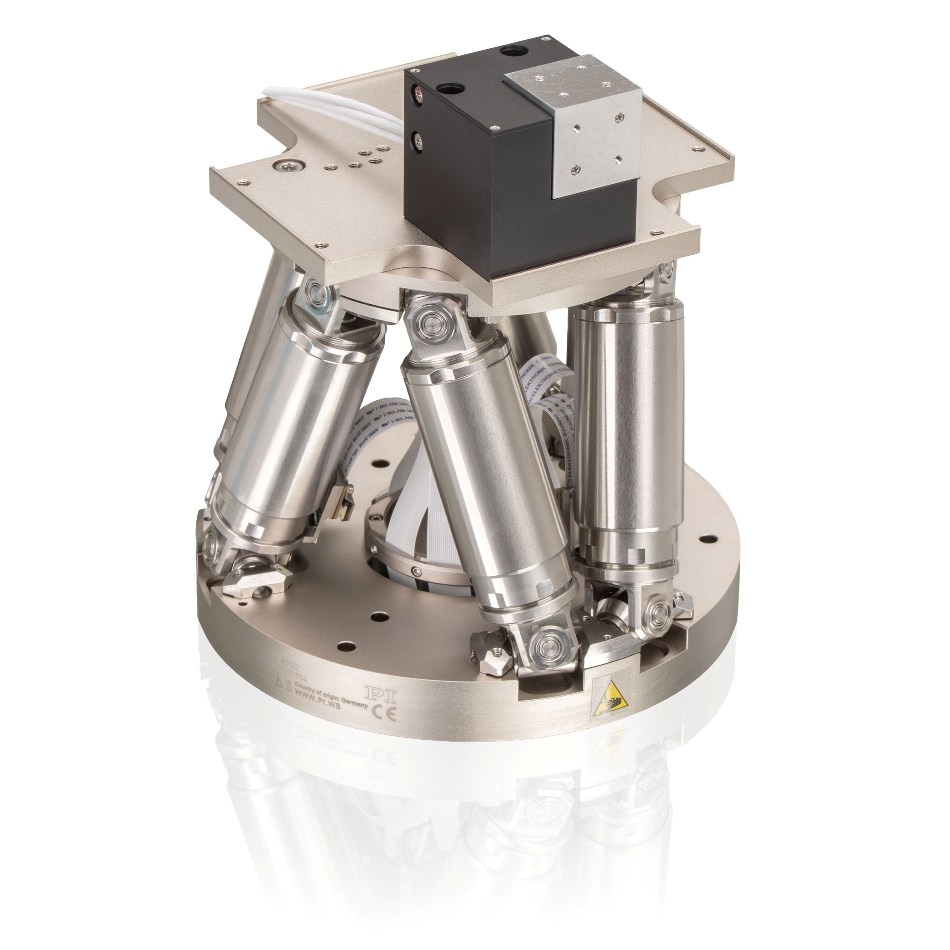In the packaging and testing of photonic components, the optical alignment must be repeated at multiple process steps and it, therefore, plays a decisive role in production economics. PI's new F-712. HU1 fiber alignment system speeds up this process by typically two orders of magnitude, enabling significant cost savings.
 The F-712.HU1 alignment micro-robot is particularly suitable for coupling entire fiber arrays to silicon photonics structures and photonic integrated circuits. Speed and, therefore, the economic efficiency of coupling processes are improved by typically two orders of magnitude whether during testing or in packaging.
The F-712.HU1 alignment micro-robot is particularly suitable for coupling entire fiber arrays to silicon photonics structures and photonic integrated circuits. Speed and, therefore, the economic efficiency of coupling processes are improved by typically two orders of magnitude whether during testing or in packaging.
PI (Physik Instrumente) presents the F-712.HU1 alignment microrobot that precisely aligns silicon photonic components or photonic integrated circuits (PICs) with fiber arrays. The system combines the proven H-811 hexapod for large travel ranges with the fast acting P-616 NanoCube® nanopositioner for accuracies in the single-digit nanometer range. In combination, the two subsystems offer nine degrees of freedom for motion purposes and enable the coupling of fibers and arrays to PICs and SiP structures. The high dynamics and wear-free working principle of the NanoCube® also allows continuous tracking for dynamic compensation of drift effects during coupling or curing of adhesives.
Parallel-Kinematic Designs
The inherent parallel-kinematic design of the hexapod provides high system stiffness in all its six degrees of freedom. The brushless DC motors in the struts of the hexapod allow for travel ranges from ± 17 mm or tilting of up to ± 21°. The pivot point can be freely defined by using software, allowing rotations about an optical axis, focal point, beam waist or other desirable position.
The P-616 NanoCube®, which also has a parallel-kinematic design, offers travel ranges of up to 100 µm in X, Y, and Z direction with a bidirectional repeatability of below 15 nm. Flexure guides and all-ceramic PICMA® actuators guarantee a long lifetime.
High-Performance Scanning Routines
PI's sophisticated scanning routines are firmware-based, that is, they are integrated directly into the controllers of the two motion systems. In comparison to PC-based software, this makes the entire scanning process significantly easier and quicker as there are practically no more command latencies. All calculations for position control are carried out in the controllers with the servo clock rate. The integrated rotational scanning routines also make the optimization of fiber arrays with all channels possible. Multiple alignments can proceed in parallel, eliminating time-consuming sequences and loops. The system can, therefore, carry out all tasks necessary in the active alignment and optimization of photonic components.
Extensive Software Package
The software package included in the scope of delivery allows the integration of the system into virtually any environment. All common operating systems such as Windows, Linux, and macOS as well as a large number of common programming languages such as C++, Python, MATLAB, and NI LabVIEW are supported. Thanks to sophisticated program examples and the use of software tools such as PIMikroMove, the time between starting integration and productive operation is shortened considerably.
Can Be Combined with the F-712.PM1 Power Meter
PI offers the F-712.PM1 power meter as a supplementary subsystem for signal acquisition. The power meter offers high resolution and extremely high bandwidth (20 kHz). It operates in a wide wavelength range from 400 nm - 1550 nm and, therefore, enables work in the visible and infrared ranges without switching.
Industrial Integration
The system is optionally available with EtherCAT® interfaces for the most sophisticated, real-time integration into high-throughput industrial systems, such as those incorporating large stages and gantries for pick-and-place and dispensing.